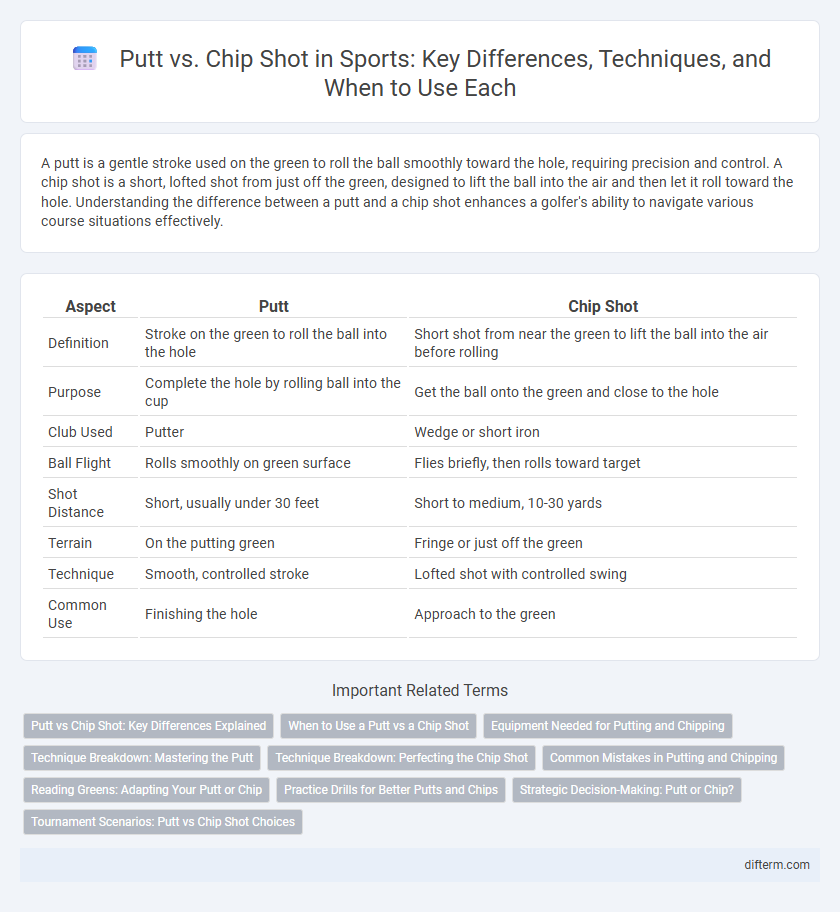A putt is a gentle stroke used on the green to roll the ball smoothly toward the hole, requiring precision and control. A chip shot is a short, lofted shot from just off the green, designed to lift the ball into the air and then let it roll toward the hole. Understanding the difference between a putt and a chip shot enhances a golfer's ability to navigate various course situations effectively.
Table of Comparison
| Aspect | Putt | Chip Shot |
|---|---|---|
| Definition | Stroke on the green to roll the ball into the hole | Short shot from near the green to lift the ball into the air before rolling |
| Purpose | Complete the hole by rolling ball into the cup | Get the ball onto the green and close to the hole |
| Club Used | Putter | Wedge or short iron |
| Ball Flight | Rolls smoothly on green surface | Flies briefly, then rolls toward target |
| Shot Distance | Short, usually under 30 feet | Short to medium, 10-30 yards |
| Terrain | On the putting green | Fringe or just off the green |
| Technique | Smooth, controlled stroke | Lofted shot with controlled swing |
| Common Use | Finishing the hole | Approach to the green |
Putt vs Chip Shot: Key Differences Explained
A putt is a gentle stroke performed on the green to roll the ball toward the hole, prioritizing precision and speed control. In contrast, a chip shot is a short, lofted stroke used off the green to lift the ball over hazards or rough and land it softly near the hole. Understanding the differences in technique, trajectory, and distance management is crucial for improving scoring in golf.
When to Use a Putt vs a Chip Shot
Use a putt on the green when the ball is rolling smoothly toward the hole, requiring precise control and minimal loft to ensure accuracy. A chip shot is ideal when the ball lies just off the green, demanding a short, lofted stroke to lift the ball over rough or fringe with a controlled roll toward the target. Choosing between a putt and a chip shot depends on lie, distance to the hole, and course conditions affecting ball movement.
Equipment Needed for Putting and Chipping
Putting requires a flat-faced putter designed to provide precision and control on the green, typically featuring a shorter shaft and a heavier clubhead for smooth roll. Chipping involves a wedge, such as a pitching or sand wedge, with a loft between 44-58 degrees to help lift the ball into the air and execute softer landings near the hole. Golfers often select equipment based on shot distance and terrain, optimizing performance through proper club choice and design features specific to putting and chipping shots.
Technique Breakdown: Mastering the Putt
Mastering the putt requires precise green reading, consistent stroke mechanics, and controlled pace to ensure the ball rolls smoothly toward the hole. Unlike chip shots, which involve loft and a shorter backswing, the putt emphasizes a pendulum-like motion with minimal wrist movement and a square clubface at impact. Focused practice on alignment, grip pressure, and follow-through can dramatically improve accuracy and distance control on the green.
Technique Breakdown: Perfecting the Chip Shot
Mastering the chip shot requires a precise technique involving a slightly open clubface and a controlled, short backswing to ensure clean contact with the ball. The key is to strike the ball first, then the ground, allowing for a smooth, low-trajectory shot that rolls toward the hole. Unlike the putt, which relies on a consistent, flat stroke on the green, the chip shot demands a delicate balance of loft and distance control to navigate hazards and uneven turf.
Common Mistakes in Putting and Chipping
Common mistakes in putting include inconsistent stroke length and improper alignment, which can lead to missed distances and inaccurate aim. In chipping, players often err by decelerating through impact or using excessive wrist movement, resulting in poor contact and inconsistent ball flight. Mastering a smooth, controlled stroke and maintaining solid body posture are essential to improving both putting and chipping performance.
Reading Greens: Adapting Your Putt or Chip
Reading greens accurately impacts both putts and chip shots by assessing slope, grain, and speed to optimize ball trajectory. Precise evaluation of break and green texture ensures effective power and direction control for putts while facilitating clean contact and desired roll on chip shots. Mastery of green conditions enables players to adjust their stroke technique, improving scoring precision across short-game scenarios.
Practice Drills for Better Putts and Chips
Improving accuracy in putts and chips requires targeted practice drills such as ladder drills for distance control and landing spot drills to master trajectory. Using alignment sticks and varying green speeds enhances stroke consistency and feel, while repetitive chip-shot drills with different clubs build confidence around the greens. Incorporating pressure simulation in practice boosts precision and decision-making during actual play.
Strategic Decision-Making: Putt or Chip?
Choosing between a putt and a chip shot hinges on factors such as distance to the hole, lie of the ball, green slope, and obstacles around the target area. A putt offers precision on smooth greens ideal for short distances, while a chip shot is favored when the ball lies just off the green or requires elevation to clear hazards. Mastering terrain assessment and stroke execution enhances scoring potential by selecting the optimal approach in complex golfing scenarios.
Tournament Scenarios: Putt vs Chip Shot Choices
In tournament scenarios, selecting between a putt and a chip shot hinges on the ball's distance from the green and the terrain's complexity. A putt is preferred on closely mown greens with minimal elevation changes, optimizing precision and speed control. Conversely, chip shots offer superior control over trajectory and spin when navigating rough or uneven lies near the green, crucial for maintaining tournament-scoring consistency.
putt vs chip shot Infographic

 difterm.com
difterm.com